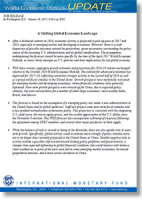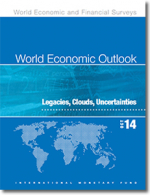World Economic Outlook 2017 Update
The World Economic Outlook (WEO) Update covers key WEO projections and is published between the Spring and Fall WEO reports.
A Shifting Global Economic Landscape
- After a lackluster outturn in 2016, economic activity is projected to pick up pace in 2017 and 2018, especially in emerging market and developing economies. However, there is a wide dispersion of possible outcomes around the projections, given uncertainty surrounding the policy stance of the incoming U.S. administration and its global ramifications. The assumptions underpinning the forecast should be more specific by the time of the April 2017 World Economic Outlook, as more clarity emerges on U.S. policies and their implications for the global economy.
- With these caveats, aggregate growth estimates and projections for 2016–18 remain unchanged relative to the October 2016 World Economic Outlook. The outlook for advanced economies has improved for 2017–18, reflecting somewhat stronger activity in the second half of 2016 as well as a projected fiscal stimulus in the United States. Growth prospects have marginally worsened for emerging market and developing economies, where financial conditions have generally tightened. Near-term growth prospects were revised up for China, due to expected policy stimulus, but were revised down for a number of other large economies—most notably India, Brazil, and Mexico.
- This forecast is based on the assumption of a changing policy mix under a new administration in the United States and its global spillovers. Staff now project some near-term fiscal stimulus and a less gradual normalization of monetary policy. This projection is consistent with the steepening U.S. yield curve, the rise in equity prices, and the sizable appreciation of the U.S. dollar since the November 8 election. This WEO forecast also incorporates a firming of oil prices following the agreement among OPEC members and several other major producers to limit supply.
- While the balance of risks is viewed as being to the downside, there are also upside risks to near-term growth. Specifically, global activity could accelerate more strongly if policy stimulus turns out to be larger than currently projected in the United States or China. Notable negative risks to activity include a possible shift toward inward-looking policy platforms and protectionism, a sharper than expected tightening in global financial conditions that could interact with balance sheet weaknesses in parts of the euro area and in some emerging market economies, increased geopolitical tensions, and a more severe slowdown in China.
Log in to download this paper.
What’s Related
Related Companies
International Monetary Fund
Related Topics
Global Trade
EconomyGlobal TradeInternational Monetary FundSupply Chain
All topics
News


IMF Boosts Global Economic Forecast for 2017
The International Monetary Fund offered a sunnier outlook for the global economy in 2017, predicting growth of 3.5 percent this year. Still, the IMF warned the world economy still ...
2016 Global Economic Growth Will Be Disappointing
Sand in the Oil of the Supply Chain
Global Growth Revised Down, Despite Cheaper Oil, Faster U.S. Growth
Why is U.S. Manufacturing Allegedly Thriving?
More News
Resources

World Economic Outlook 2017 Update
The World Economic Outlook (WEO) Update covers key WEO projections and is published between the Spring and Fall WEO reports.

World Economic Outlook - Legacies, Clouds, Uncertainties
Among advanced economies, the United States and the United Kingdom in particular are leaving the crisis behind and achieving decent growth - though even for those two countries, po...
More Resources
Favorites

How Does IKEA’s Inventory Management Supply Chain Strategy Really Work?
Each IKEA store is huge and holds more than 9,500 products! How in the world does IKEA offer so...

Starbucks as an Example of the Value Chain Model
The concept of value chain helps to understand and segregate the useful (which help in gaining a competitive...

7 Principles of Supply Chain Management Explained
Would you like to understand supply chain management concepts but don't have time to study from a textbook?...

Is Apple’s Supply Chain Really the No. 1? A Case Study
How Complex is Apple's Supply Chain? Some people in the blogosphere said that Apple's Supply Chain is not...

